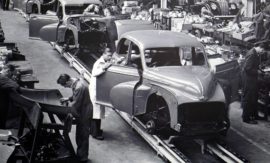| ASCM22 | Pittman, P. et al., ASCM Dictionary, 17th Ed., APICS/ASCM, Chicago, 2022 |
| Schi01 | Schierholt, K., “Process Configuration — Mastering Knowledge-Intensive Planning Tasks,” vdf Hochschul-verlag, Zurich, 2001 |
| Schö88a | Schönsleben, P., “Flexibilität in der computergestützten Produktionsplanung und -steuerung,” 2nd Edition, AIT-Verlag, D-Hallbergmoos, 1988 |
| Schö88b | Schönsleben, P., “Expertensysteme als Hilfsmittel der variantenreichen Produktkonfiguration,” in Informatik, Forschung und Entwicklung, Springer, Berlin, 1988 |
| Schö12 | Schönsleben, P., “Methods and tools that support a fast and efficient design-to-order process for parameterized product families,” Annals of the CIRP, 61/1:179-182, 2012 |
| Schw96 | Schwarze, S., “Configuration of Multiple Variant Products,” BWI-Reihe Forschungsberichte für die Unternehmenspraxis, vdf Hochschulverlag, Zurich, 1996 |
| SöLe96 | Schönsleben, P., Leuzinger, R., “Innovative Gestaltung von Versicherungsprodukten: Flexible Industriekonzepte in der Assekuranz,” Gabler, Wiesbaden, 1996 |
| WiPo15 | Willner, O., Powell, D., Gerschberger, M., Schönsleben, P., “Exploring the Archetypes of Engineer-to-Order: An Empirical Analysis,” International Journal of Operations and Production Management, DOI - 10.1108/IJOPM-07-2014-0339, 2015 |
Course 7: Sections and their intended learning outcomes

Course 7 – The Concept for Product Families and One-of-a-Kind Production
Intended learning outcomes: Produce logistics characteristics of a product variety concept. Explain adaptive and generative techniques in detail. Describe the use of generative and adaptive techniques for engineer-to-order. Differentiate various ways of cooperation between R&D and Engineering in ETO Companies.

7.1 Logistics Characteristics of a Product Variety Concept
Intended learning outcomes: Differentiate between high-variety and low-variety manufacturing. Describe different variant-oriented techniques, and the final assembly schedule.

7.2 Adaptive Techniques
Intended learning outcomes: Explain techniques for standard products with few variants as well as techniques for product families.

7.3 Generative Techniques
Intended learning outcomes: Disclose the combinatorial aspect and the problem of redundant data. Present variants in bills of material and routing sheets as production rules of a knowledge-based system. Explain the use of production rules in order processing.

7.4 Generative and Adaptive Techniques for Engineer-to-Order (ETO)
Intended learning outcomes: Differentiate between the classical procedure and different archetypes of engineer-to-order. Describe the approach for basic and for repeatable engineer-to-order.

7.5 Cooperation between R&D and Engineering in ETO Companies
Intended learning outcomes: Describe different means used for cooperation between the R&D and the order-specific engineering departments. Present the portfolio of cooperation types between R&D and engineering in ETO companies.

7.6 Summary
.

7.7 Keywords
.

7.8 Scenarios and Exercises
Intended learning outcomes: Apply adaptive techniques for product families. Disclose the use of production rules in order processing. Elaborate the setting the parameters of a product family.

7.9 References
.
